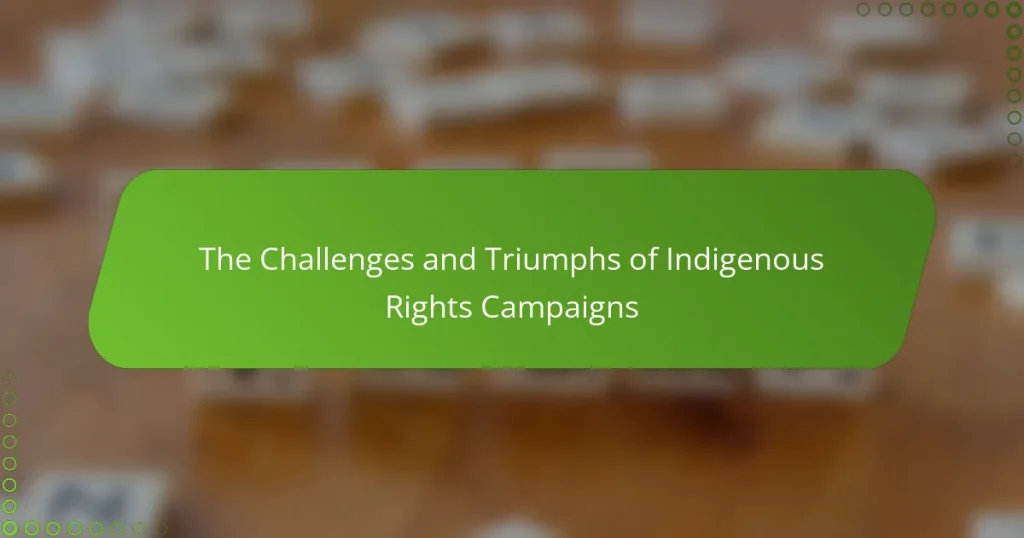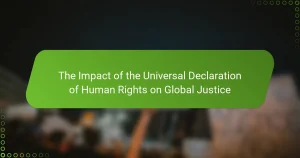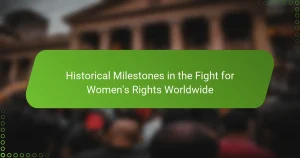Indigenous rights campaigns focus on advocating for the rights and recognition of Indigenous peoples, particularly concerning land ownership, cultural preservation, and political representation. These campaigns face significant challenges, including legal recognition of land rights, cultural assimilation pressures, limited funding, political resistance, and public misinformation. Despite these obstacles, Indigenous rights campaigns have achieved notable victories, such as the recognition of native title in Australia and the adoption of the United Nations Declaration on the Rights of Indigenous Peoples. Effective strategies for enhancing these campaigns include coalition-building, social media engagement, and grassroots mobilization, which have proven successful in fostering community involvement and raising awareness.
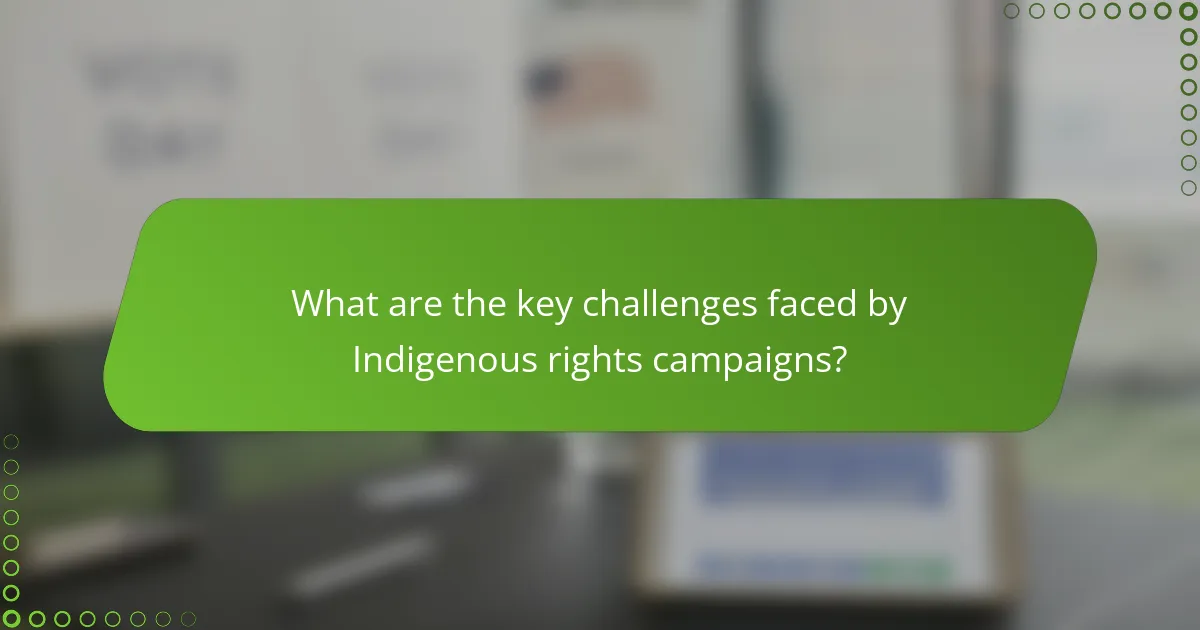
What are the key challenges faced by Indigenous rights campaigns?
Indigenous rights campaigns face several key challenges. One major challenge is legal recognition. Many Indigenous groups struggle to have their land rights acknowledged by governments. This often leads to conflicts over resource extraction and land use. Another challenge is cultural preservation. Indigenous cultures are at risk due to globalization and assimilation pressures. Additionally, funding and resources for advocacy are frequently limited. Many campaigns rely on grassroots efforts, which can be underfunded. Political resistance also poses a significant barrier. Governments may oppose Indigenous rights due to economic interests. Lastly, misinformation and stereotypes can undermine public support for these campaigns. This can hinder progress and create additional obstacles.
How do historical injustices impact current Indigenous rights efforts?
Historical injustices significantly impact current Indigenous rights efforts by shaping the socio-political landscape. These injustices include colonization, land dispossession, and cultural erasure. Such historical events have led to systemic inequalities that persist today. Indigenous communities often face challenges in asserting their rights due to these legacies. For instance, treaties made in the past are frequently ignored or inadequately honored. This creates distrust between Indigenous peoples and governmental entities. Furthermore, historical trauma affects community cohesion and activism. Studies show that addressing these injustices is crucial for effective rights advocacy. Acknowledgment of past wrongs is essential for building a foundation for current efforts.
What specific historical events have shaped Indigenous rights movements?
The specific historical events that have shaped Indigenous rights movements include the establishment of the Indian Act in Canada in 1876. This legislation aimed to control Indigenous peoples and their lands. The American Indian Movement (AIM) emerged in the 1960s, advocating for civil rights and sovereignty. The 1973 Wounded Knee Incident highlighted issues of police brutality and land rights. The 1992 United Nations Declaration on the Rights of Indigenous Peoples recognized Indigenous rights globally. The 2007 Apology to the Stolen Generations in Australia acknowledged past injustices against Indigenous peoples. The Truth and Reconciliation Commission in Canada, initiated in 2008, aimed to address the legacy of residential schools. Each of these events significantly influenced Indigenous rights advocacy and awareness.
How do these historical injustices continue to affect Indigenous communities today?
Historical injustices continue to affect Indigenous communities today through systemic inequality and cultural disintegration. Many Indigenous peoples experience higher rates of poverty and unemployment compared to non-Indigenous populations. For example, the 2016 Census reported that the Indigenous unemployment rate was 11.5%, significantly higher than the national average of 6.9%.
Additionally, historical trauma has led to mental health challenges within these communities. Indigenous youth are more likely to experience depression and anxiety, with suicide rates among Indigenous youth being five to seven times higher than their non-Indigenous peers.
Access to healthcare and education remains limited for many Indigenous communities. A study by the Canadian Institute for Health Information in 2019 found that Indigenous peoples face barriers to receiving adequate healthcare, contributing to poorer health outcomes.
Land dispossession and ongoing disputes over land rights hinder economic development and self-determination for Indigenous peoples. The United Nations Declaration on the Rights of Indigenous Peoples emphasizes the importance of land rights, yet many communities continue to fight for recognition and restitution.
These factors illustrate how historical injustices have lasting impacts on the social, economic, and cultural well-being of Indigenous communities today.
What legal barriers exist for Indigenous rights campaigns?
Legal barriers for Indigenous rights campaigns include restrictive legislation and lack of recognition of Indigenous sovereignty. Many countries have laws that limit the ability of Indigenous groups to assert their rights. These laws often prioritize state interests over Indigenous land claims. Additionally, legal frameworks may not adequately address historical injustices faced by Indigenous communities. Courts may also exhibit bias against Indigenous rights claims. In many instances, the burden of proof falls heavily on Indigenous groups. This creates significant challenges in legal battles for land and resource rights. The complexity of legal systems can further hinder Indigenous advocacy efforts.
Which laws hinder Indigenous rights advocacy?
Laws that hinder Indigenous rights advocacy include the Indian Act in Canada and the Native American Graves Protection and Repatriation Act in the United States. The Indian Act restricts Indigenous governance and land rights, limiting self-determination. It has been criticized for imposing colonial structures on Indigenous communities. The Native American Graves Protection and Repatriation Act often complicates the repatriation of Indigenous remains and cultural artifacts. These laws create barriers to effective advocacy by undermining Indigenous sovereignty and rights. Additionally, laws regarding land use and resource extraction frequently prioritize economic development over Indigenous land rights. This legal framework marginalizes Indigenous voices in decision-making processes.
How do legal frameworks differ across countries regarding Indigenous rights?
Legal frameworks regarding Indigenous rights vary significantly across countries. In some nations, like Canada and New Zealand, legal systems recognize Indigenous rights through treaties and constitutional protections. These frameworks often include land rights, self-governance, and cultural preservation.
In contrast, countries such as Brazil and Australia have faced challenges in fully recognizing these rights. Brazil’s legal framework has seen fluctuating protections, influenced by political changes and economic interests. Australia has made strides with the Native Title Act but still grapples with issues of land rights and recognition.
The United States has a unique model that acknowledges tribal sovereignty, yet this is often limited by federal and state laws. Countries like Norway and Sweden have integrated Indigenous rights into their legal systems, focusing on Sami rights and land management.
These differences reflect historical contexts, political will, and societal attitudes towards Indigenous populations. Understanding these nuances is crucial for effective advocacy and policy-making in the realm of Indigenous rights.
What social challenges do Indigenous rights campaigns encounter?
Indigenous rights campaigns encounter significant social challenges. These challenges include systemic discrimination and marginalization of Indigenous communities. Many Indigenous people face cultural appropriation, which undermines their identities and traditions. Additionally, misinformation about Indigenous issues often leads to public misunderstanding. Limited access to resources hampers the effectiveness of these campaigns. There is also resistance from state and corporate interests that prioritize economic development over Indigenous rights. Furthermore, internal divisions within Indigenous communities can complicate advocacy efforts. These factors collectively hinder the progress of Indigenous rights campaigns.
How does public perception affect Indigenous rights advocacy?
Public perception significantly influences Indigenous rights advocacy. Positive public perception can lead to increased support for Indigenous causes. This support often manifests in policy changes and funding for initiatives. Conversely, negative public perception can hinder advocacy efforts. It may result in decreased funding and political resistance. Public opinion shapes the narrative around Indigenous issues. Media representation plays a crucial role in forming this perception. Studies show that positive media coverage correlates with greater public support. For example, campaigns highlighting Indigenous culture and rights have successfully shifted public attitudes.
What role does media representation play in shaping these perceptions?
Media representation significantly influences public perceptions of Indigenous rights. Positive portrayals can foster understanding and empathy. Conversely, negative depictions often reinforce stereotypes and misconceptions. Research shows that media narratives shape societal attitudes. For instance, a study by the Canadian Broadcasting Corporation found that accurate media representation can lead to increased support for Indigenous issues. This highlights the power of media in advocacy. Thus, media representation plays a crucial role in shaping perceptions of Indigenous rights campaigns.
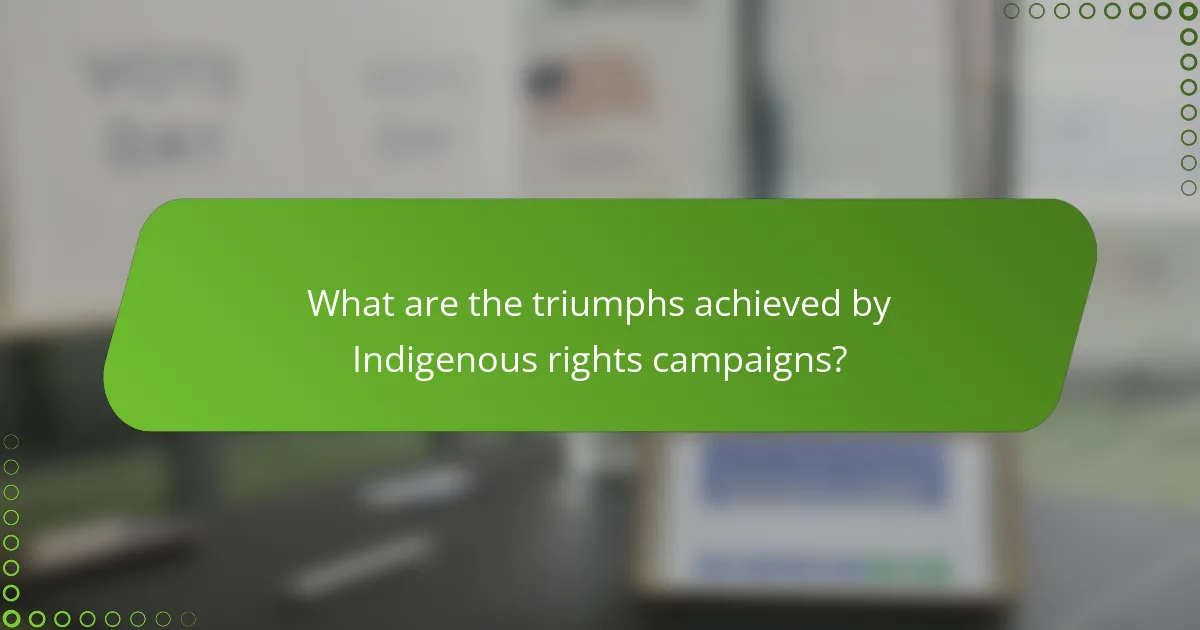
What are the triumphs achieved by Indigenous rights campaigns?
Indigenous rights campaigns have achieved significant legal and political victories. These campaigns have resulted in the recognition of land rights for Indigenous peoples in various countries. Notably, the landmark case of Mabo v Queensland (1992) in Australia recognized native title, altering property law. Additionally, the United Nations Declaration on the Rights of Indigenous Peoples was adopted in 2007, affirming the rights of Indigenous populations globally. Indigenous communities have also gained increased representation in political systems, influencing policy decisions. Furthermore, many campaigns have successfully raised awareness about cultural preservation and environmental protection. These triumphs illustrate the ongoing impact of Indigenous rights advocacy.
How have Indigenous rights campaigns successfully influenced policy changes?
Indigenous rights campaigns have successfully influenced policy changes through grassroots activism and legal advocacy. These campaigns raise awareness about the rights and issues faced by Indigenous communities. For example, the Idle No More movement in Canada mobilized thousands to advocate for Indigenous sovereignty and environmental protection. This activism led to significant policy discussions and commitments from the government. Additionally, legal cases such as the 2014 Tsilhqot’in Nation v. British Columbia decision affirmed land rights for Indigenous peoples. These actions demonstrate how sustained advocacy can lead to tangible changes in policy and recognition of Indigenous rights.
What landmark legislation has been passed as a result of these campaigns?
The landmark legislation passed as a result of Indigenous rights campaigns includes the Indian Self-Determination and Education Assistance Act of 1975. This act empowered tribes to manage their own education and social services. Another significant law is the American Indian Religious Freedom Act of 1978, which protects the religious practices of Native Americans. Additionally, the Native American Graves Protection and Repatriation Act of 1990 addresses the return of Native American cultural items. These laws were influenced by decades of advocacy and activism from Indigenous communities. Each piece of legislation reflects the ongoing struggle for recognition and rights.
How do these policy changes benefit Indigenous communities?
Policy changes benefit Indigenous communities by recognizing their rights and enhancing self-determination. These changes often lead to improved access to resources and services. For instance, land rights policies enable Indigenous groups to manage their ancestral lands sustainably. This management can result in better environmental stewardship and preservation of cultural heritage. Additionally, policy shifts may provide financial support for community-led initiatives. Evidence shows that such initiatives can lead to economic growth and job creation within these communities. Overall, these policy changes foster empowerment and resilience among Indigenous populations.
What role do grassroots movements play in the success of Indigenous rights campaigns?
Grassroots movements are crucial for the success of Indigenous rights campaigns. They mobilize local communities to advocate for their rights. These movements raise awareness about Indigenous issues. They also foster solidarity among diverse groups. Grassroots efforts often lead to increased political pressure on governments. This pressure can result in policy changes that benefit Indigenous communities. Historical examples include the American Indian Movement in the 1970s. This movement significantly influenced U.S. policy regarding Native American rights. Grassroots movements also utilize social media to amplify their message. This modern approach helps reach a wider audience and gain support.
How have grassroots initiatives led to greater awareness and support?
Grassroots initiatives have significantly increased awareness and support for Indigenous rights. These initiatives empower local communities to advocate for their needs and issues. They often involve mobilizing community members to participate in campaigns and events. This participation creates a shared sense of purpose and solidarity. As a result, more individuals become informed about Indigenous issues. Social media platforms amplify grassroots messages, reaching wider audiences quickly. For example, campaigns like #IdleNoMore gained international attention. This visibility leads to increased public support and policy discussions. Grassroots efforts also foster partnerships with organizations that advocate for social justice. These collaborations enhance resource sharing and strategic planning. Overall, grassroots initiatives play a crucial role in advancing Indigenous rights awareness and support.
What are some notable examples of successful grassroots campaigns?
Notable examples of successful grassroots campaigns include the Dakota Access Pipeline protests and the Standing Rock Sioux Tribe’s fight against environmental degradation. The Dakota Access Pipeline protests in 2016 mobilized thousands of activists to oppose the construction of the pipeline, which threatened sacred lands and water sources. This campaign garnered national and international attention, highlighting indigenous rights and environmental issues.
Another example is the Idle No More movement, which began in Canada in 2012. This movement aimed to raise awareness about indigenous sovereignty and environmental concerns. It successfully organized protests and educational events across Canada and beyond, influencing public discourse on indigenous rights.
These campaigns demonstrate the power of grassroots organizing in advocating for indigenous rights and environmental justice. They mobilized community support and attracted media coverage, amplifying their messages on a larger scale.
How do alliances with non-Indigenous groups strengthen Indigenous rights campaigns?
Alliances with non-Indigenous groups strengthen Indigenous rights campaigns by amplifying voices and increasing resources. These partnerships create a broader platform for advocacy. Non-Indigenous allies can leverage their networks to raise awareness. They often contribute funding and logistical support, enhancing campaign reach. Collaborations can also foster mutual understanding of Indigenous issues. Historical examples, such as the 1970s land rights movements in Australia, demonstrate this effectiveness. In these cases, non-Indigenous support helped to secure significant policy changes. Ultimately, these alliances create a united front against systemic injustices faced by Indigenous communities.
What types of partnerships have proven effective in advocating for Indigenous rights?
Collaborative partnerships between Indigenous communities and NGOs have proven effective in advocating for Indigenous rights. These partnerships leverage resources and expertise to amplify Indigenous voices. For example, organizations like Amnesty International work alongside Indigenous leaders to address human rights violations. Academic partnerships also contribute by providing research and policy recommendations. Collaborative efforts with legal entities help in navigating complex legal frameworks. Such partnerships have led to successful campaigns for land rights and environmental protections. The success of these partnerships is evidenced by landmark legal victories in various countries.
How can these alliances help amplify Indigenous voices?
Alliances can amplify Indigenous voices by providing broader platforms for expression. These partnerships often leverage resources and networks that Indigenous communities may lack. Collaborations can enhance visibility for Indigenous issues in mainstream media. They can also facilitate access to funding for Indigenous-led initiatives. Research indicates that collective advocacy increases the likelihood of policy changes. For example, the collaboration between Indigenous groups and environmental organizations has led to significant legal victories. These alliances also foster solidarity and mutual support among diverse communities. Ultimately, they create a united front that challenges systemic injustices faced by Indigenous peoples.
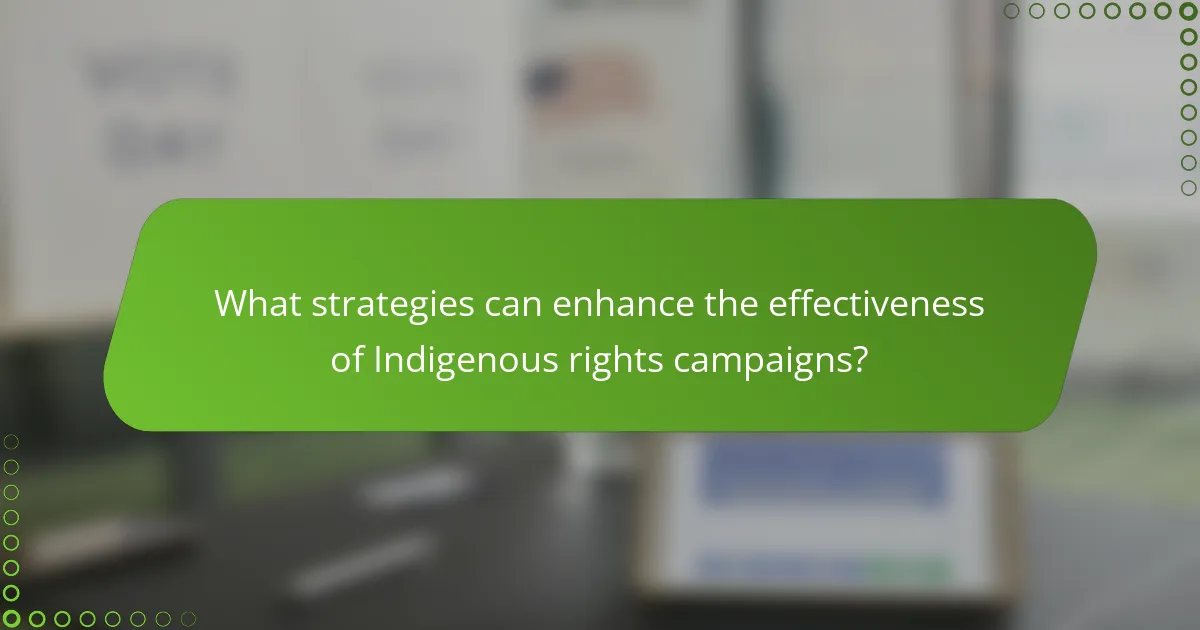
What strategies can enhance the effectiveness of Indigenous rights campaigns?
Effective strategies for enhancing Indigenous rights campaigns include building coalitions, leveraging social media, and engaging in grassroots mobilization. Coalitions unite diverse groups for a stronger voice. This collaboration can amplify messages and resources. Social media serves as a powerful tool for raising awareness and reaching wider audiences. It enables real-time communication and mobilization of supporters. Grassroots mobilization fosters community involvement and ownership of the campaign. Engaging local communities ensures that their voices and needs are prioritized. Research shows that campaigns incorporating these strategies are more likely to achieve legislative and social change. For instance, the 2016 Standing Rock protests effectively utilized social media to gain international support.
How can technology be leveraged to support Indigenous rights advocacy?
Technology can be leveraged to support Indigenous rights advocacy through digital platforms and tools. These platforms facilitate communication and mobilization among Indigenous communities. Social media enables the sharing of stories and experiences, raising awareness about rights issues. Online petitions can gather support for Indigenous causes quickly and effectively. Geographic information systems (GIS) help document land rights and environmental impacts. Virtual reality experiences can educate non-Indigenous audiences about Indigenous cultures and challenges. Data analytics can track the effectiveness of advocacy campaigns. These technological applications empower Indigenous voices and enhance their advocacy efforts.
What digital tools are most effective for mobilizing support?
Social media platforms are the most effective digital tools for mobilizing support. They enable rapid communication and engagement with a wide audience. Platforms like Facebook, Twitter, and Instagram facilitate sharing of information and rallying support. According to a study by the Pew Research Center, 69% of adults in the U.S. use social media. This broad usage makes it an ideal space for advocacy campaigns. Additionally, tools like Change.org allow users to create and share petitions easily. This can lead to significant mobilization around specific issues. Email campaigns through platforms like Mailchimp also effectively reach supporters directly. These tools collectively enhance outreach and foster community engagement.
How can social media campaigns raise awareness for Indigenous issues?
Social media campaigns can significantly raise awareness for Indigenous issues through targeted messaging and community engagement. These campaigns leverage platforms like Facebook, Twitter, and Instagram to disseminate information rapidly. They can highlight specific Indigenous rights violations or cultural celebrations. Engaging visuals and storytelling can evoke emotional responses, increasing shareability. Hashtags can unify conversations and amplify reach, as seen with #LandBack and #MMIWG. According to a 2020 report by the Pew Research Center, 69% of Americans use social media, making it a potent tool for outreach. Furthermore, social media allows Indigenous voices to be heard directly, bypassing traditional media filters. This direct communication fosters solidarity and mobilizes support for advocacy efforts.
What best practices should be followed in Indigenous rights campaigning?
Best practices in Indigenous rights campaigning include prioritizing community engagement and respecting Indigenous voices. Campaigns should involve Indigenous leaders and communities at every stage. This ensures that initiatives align with their needs and aspirations. Building trust is crucial for effective collaboration. Transparency in communication fosters stronger relationships with Indigenous groups. Additionally, campaigns should focus on educating the public about Indigenous rights and histories. Utilizing accurate data and historical context enhances credibility. Employing culturally appropriate messaging is vital to resonate with target audiences. Finally, leveraging partnerships with ally organizations can amplify efforts and resources.
How can campaigns ensure they are inclusive and representative of diverse Indigenous voices?
Campaigns can ensure inclusivity and representation of diverse Indigenous voices by actively engaging with Indigenous communities. This involves consulting with a wide range of Indigenous leaders and organizations. Campaigns should prioritize collaboration to understand specific cultural contexts and needs. Utilizing Indigenous media and platforms for outreach can amplify these voices. Training staff on cultural competency is essential for respectful engagement. Additionally, campaigns should reflect the diversity within Indigenous communities, acknowledging different languages, traditions, and perspectives. Evidence shows that inclusive campaigns can lead to more effective advocacy, as seen in successful initiatives like the #LandBack movement.
What are the key elements of a successful Indigenous rights campaign?
Key elements of a successful Indigenous rights campaign include strong community engagement, clear messaging, and strategic partnerships. Community engagement ensures that Indigenous voices are central to the campaign. This fosters trust and authenticity. Clear messaging articulates the campaign’s goals and resonates with both Indigenous and non-Indigenous audiences. Strategic partnerships with organizations, allies, and legal experts can amplify the campaign’s reach and resources. Evidence from successful campaigns shows that these elements lead to greater visibility and impact. For instance, the Standing Rock movement effectively utilized these elements to raise awareness about water rights.
What common pitfalls should Indigenous rights campaigns avoid?
Indigenous rights campaigns should avoid tokenism. Tokenism undermines genuine representation and can alienate communities. Campaigns must prioritize authentic engagement with Indigenous voices. They should also avoid oversimplifying complex issues. Simplified narratives can misrepresent the diversity of Indigenous experiences. Furthermore, campaigns should not ignore historical contexts. Ignoring history can lead to misunderstandings and ineffective strategies. Additionally, campaigns must avoid a one-size-fits-all approach. Each Indigenous community has unique needs and perspectives. Lastly, campaigns should not neglect the importance of allyship. Effective allyship requires ongoing commitment and support for Indigenous leadership.
How can campaigns navigate cultural sensitivities effectively?
Campaigns can navigate cultural sensitivities effectively by conducting thorough research on the communities involved. Understanding cultural values, beliefs, and practices is essential. Engaging with community leaders and members fosters trust and collaboration. Campaigns should also tailor their messaging to reflect cultural contexts accurately. This approach helps avoid misrepresentation and offense. Utilizing culturally relevant symbols and languages can enhance relatability. Continuous feedback from the community ensures that campaigns remain sensitive to evolving cultural dynamics. Successful examples include campaigns that prioritize inclusive dialogue and respect for indigenous traditions.
What lessons can be learned from past campaign failures?
Past campaign failures provide critical lessons for future initiatives. One key lesson is the importance of understanding the target audience. Misalignment with community values can lead to rejection. Another lesson is the need for thorough research and data analysis. Campaigns lacking evidence often fail to resonate. Additionally, clear and transparent communication is essential. Miscommunication can create distrust and hinder support. Engaging stakeholders early in the process is also crucial. This fosters collaboration and reduces resistance. Finally, adaptability is vital. Campaigns must be willing to pivot based on feedback and changing circumstances. These insights can enhance the effectiveness of future Indigenous rights campaigns.
The main entity of this article is Indigenous rights campaigns, which face various challenges and celebrate significant triumphs. Key challenges include legal recognition, cultural preservation, funding limitations, political resistance, and public misinformation. Historical injustices and legal barriers further complicate advocacy efforts, while social challenges and public perception significantly influence campaign effectiveness. The article also highlights successful grassroots movements and partnerships that have led to policy changes and increased recognition of Indigenous rights, outlining strategies for enhancing campaign effectiveness and avoiding common pitfalls.
